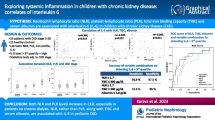Abstract
Chronic kidney insufficiency (CKI) is often the end point of a broad range of chronic kidney diseases and characterized with decreasing number of functionally active nephrons. Pathophysiological CKI is characterized by decreased glomerular filtration, which leads to accumulation of life-threatening toxic metabolites. Hemodialysis is the main therapeutic measure aimed to prolong patient’s life until kidney transplant is available. The goal of this study is to analyze serum level of 21 cytokines in CKI. We have found that the serum level of several (IL-2Rα, IL-3, IL-12 (p40), IL-16, IL-18, HGF, MIF, CSF-1, MCP-3, CXCL12, SCF, IFN-α2, LIF, β-NGF, and CXCL1) cytokines and chemokines was upregulated in CKI without hemodialysis as compared to controls (p = 0.005). Interestingly, serum cytokines were also upregulated in serum of CKI patients who received hemodialysis. Upregulated cytokines are associated with inflammation and activation of Th1 lymphocytes. We suggest that hemodialysis has limited effect on serum cytokine levels. It could be concluded that therapeutic effect of hemodialysis is not associated with removal of inflammatory cytokines from circulation. Further studies will help better define the underlying cause of an increased inflammation in CKI and identify the laboratory criteria for anti-inflammatory therapy.

Similar content being viewed by others
References
Jha, V., et al. (2013). Chronic kidney disease: global dimension and perspectives. Lancet, 382(9888), 260–272.
Carrero, J. J., et al. (2009). Cytokines, atherogenesis, and hypercatabolism in chronic kidney disease: a dreadful triad. Semin Dial, 22(4), 381–386.
Bastos, K. R., et al. (2002). Macrophages from IL-12p40-deficient mice have a bias toward the M2 activation profile. J Leukoc Biol, 71(2), 271–278.
Cooper, A. M., & Khader, S. A. (2007). IL-12p40: an inherently agonistic cytokine. Trends Immunol, 28(1), 33–38.
Shimizu, M., et al. (2015). Interleukin-18 for predicting the development of macrophage activation syndrome in systemic juvenile idiopathic arthritis. Clin Immunol, 160(2), 277–281.
Dietsch, G. N., et al. (2016). Coordinated activation of toll-like receptor8 (TLR8) and NLRP3 by the TLR8 agonist, VTX-2337, ignites tumoricidal natural killer cell activity. PLoS One, 11(2), e0148764.
Center, D. M., Kornfeld, H., & Cruikshank, W. W. (1996). Interleukin 16 and its function as a CD4 ligand. Immunol Today, 17(10), 476–481.
Hart, P. H. (2001). Regulation of the inflammatory response in asthma by mast cell products. Immunol Cell Biol, 79(2), 149–153.
Cruikshank, W. W., et al. (1987). Lymphokine activation of T4+ T lymphocytes and monocytes. J Immunol, 138(11), 3817–3823.
Zhang, T., et al. (2016). CXCL1 mediates obesity-associated adipose stromal cell trafficking and function in the tumour microenvironment. Nat Commun, 7, 11674.
Aloe, L., et al. (2015). Nerve growth factor: a focus on neuroscience and therapy. Curr Neuropharmacol, 13(3), 294–303.
Witte, O. N. (1990). Steel locus defines new multipotent growth factor. Cell, 63(1), 5–6.
Junttila, I., et al. (2003). M-CSF induced differentiation of myeloid precursor cells involves activation of PKC-delta and expression of Pkare. J Leukoc Biol, 73(2), 281–288.
Rosen, E. M., et al. (1997). HGF/SF in angiogenesis. CIBA Found Symp, 212, 215–226 discussion 227-9.
Ishiki, Y., et al. (1992). Direct evidence that hepatocyte growth factor is a hepatotrophic factor for liver regeneration and has a potent antihepatitis effect in vivo. Hepatology, 16(5), 1227–1235.
Kawaida, K., et al. (1994). Hepatocyte growth factor prevents acute renal failure and accelerates renal regeneration in mice. Proc Natl Acad Sci U S A, 91(10), 4357–4361.
Yaekashiwa, M., et al. (1997). Simultaneous or delayed administration of hepatocyte growth factor equally represses the fibrotic changes in murine lung injury induced by bleomycin. A morphologic study. Am J Respir Crit Care Med, 156(6), 1937–1944.
Nakamura, T., & Mizuno, S. (2010). The discovery of hepatocyte growth factor (HGF) and its significance for cell biology, life sciences and clinical medicine. Proc Jpn Acad Ser B Phys Biol Sci, 86(6), 588–610.
Rohrschneider, L. R., et al. (1997). Growth and differentiation signals regulated by the M-CSF receptor. Mol Reprod Dev, 46(1), 96–103.
Lam, C. W. K. (2009). Inflammation cytokines and chemokines in chronic kidney disease. eJIFCC, 20, 19.
Acknowledgments
The work is performed according to the Russian Government Program of Competitive Growth of Kazan Federal University and subsidy allocated to Kazan Federal University for the state assignment in the sphere of scientific activities. The research was performed using the equipment of the Interdisciplinary Center for Collective Use of Kazan Federal University, supported by Ministry of Education of Russia (ID RFMEFI59414X0003).
Author information
Authors and Affiliations
Corresponding author
Rights and permissions
About this article
Cite this article
Romanova, Y.D., Markelova, M.I., Laikov, A.V. et al. Cytokine Levels in the Serum of Patients with Chronic Kidney Insufficiency Before and After Hemodialysis. BioNanoSci. 7, 415–418 (2017). https://doi.org/10.1007/s12668-016-0379-6
Published:
Issue Date:
DOI: https://doi.org/10.1007/s12668-016-0379-6




